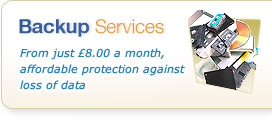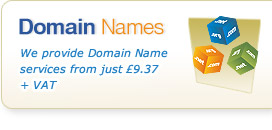What is this IPv6 stuff anyway?
18th June 2012
In recent weeks there has been a lot of hype surrounding a technical sounding term known as IPv6. If you believe the BBC, the "Internet" had some sort of major upgrade overnight recently, causing it to have some magical new technology. Unfortunately the BBC got it really rather wrong. There was no magical sudden upgrade, and all that really happened was a day to promote a new technology and the addition of many popular sites adding support for the technology ready for the future.
IPv6 is effectively something that in the main can be best left to IT geek's and the like to worry about, as in all practical purposes on an every day basis, the typical small business owner does not need to care about it - and it should just be sorted out by those types of people as it becomes necessary to adopt it.
Whilst the technical side of it isn't something to worry about, you do need to be aware of this IPv6 thing as it will make a difference in the coming years.
So what is it?
Put simply, it's like having a new post code system for the internet. If you think about a typical british post code, they're in the format of AB1 CD2 or AB1C 1DE. Each area gets its own postcode, and they serve a small bunch of actual addresses. Today's Internet uses a postcode system of sorts, known as IPv4.
When IPv4 came about and was introduced as the standard for the Internet, it was actually pretty handy, because unlike a postcode, the idea in principle was actually that every single address had a unique "postcode" - so I could be as specific as to find "your house" from a postcode, rather than the approximate road you're in. This system worked well initially, but, just like postcodes in a set format, there are only so many you can actually have.
With IPv4, the current widespread "postcode" system, as demand for connections to the Internet have risen, the amount of those addresses available has diminished. For various reasons too, technologies such as "NAT" turned up. This stands for Network Address Translation. In the "postcode" term, it is much like today's postcodes - your broadband router has been given a postcode, which is visible from the internet, but just like if I navigate to your postcode, broadband routers using NAT mean I can't quite get to the actual computer that asked for something, just the broadband router (the postcode area). NAT is a clever little thing, because it is a bit like a knowledgeable local - whilst the visitor coming to your postcode doesn't actually know where your house is, when it gets to the postcode it was given, that knowledgeable local can take over and knows where you actually live and how to get you there.
So we have a problem whereby we can no longer go directly to where we need to go - the majority of us using broadband have to go via this NAT stuff on our local broadband router, and keep translating stuff via the knowledgeable local. Of course like the local, they'll hold you up with various tales of the past, funny stories and occasionally forget to pass on a message you had for someone.
There's also the issue that more and more people have an Internet Connection - so they need a postcode to themselves. All sorts of things influence that, such as:
- More and more "server" systems on the internet that generally must have a postcode each - and can't share so easily (or at all)
- Huge rises in some parts of the world in demand and use of Internet Connectivity (especially in the Asia region)
- More and more of us own several bits of equipment that go on the internet - from laptops to phones, tablets and ipads, one for work, one for personal, smart TVs... the list goes on). Sometimes they don't share - so when you're out and about using your mobile it'll be using a different "knowledgeable local" when you're in town to when you're at home etc.
In total, using IPv4 there are a maximum of 4,294,967,296 different postcodes in a best case scenario. That sounds a lot, but actually, we've pretty much run out across the globe.
So this IPv6 thing is really about a new postcode system. At a technical level it also takes opportunity to address various shortcomings in the old IPv4 system (which was put together many years ago, and couldn't possibly have for seen everything that happens today), as well as give us more postcodes.
The reason it is a big deal is that it isn't directly compatible with the old system. To use it, everything has to understand it - the computer or mobile device you're using, the equipment that connects to, and all the other connections on the way to wherever you're trying to visit. If any part of it doesn't understand it, then it all goes horribly wrong.
Why does this affect my business?
At a small business level it means that broadband routers, firewalls, servers and computers need to understand it, our broadband providers have to support it. In the majority of cases the equipment you'll be using today (particularly if it is a few years old) won't understand this new postcode system, and won't be upgradable to understand it either. This means sooner or later you WILL need to buy new equipment. It also means you should be starting to ask if equipment you're getting (especially if you're not renting it or given it as part of a service) can support this new system, IPv6.
You'll need to budget for equipment, for setup time and potentially quite considerable changes or new implementations when it does become necessary for you. When this is will depend on what you're doing, what your systems need, and whether there are any spare IPv4 addresses allocated to you or made available for you to use.
It also means that some legacy systems may eventually have to be replaced - there are ways to make both systems co-exist, but they're not flawless, and do have other side effects. Even if there are short term workarounds, they will be short lived, so expect your IT people to start uttering about these upgrades, changes and new equipment sooner or later!
And a couple more things...
IPv6 isn't actually new - the BBC and others have portrayed it as new, but actually it has been around for some time - there are limited providers who've been using these addresses for 10 years or so in some capacity while others haven't begun at all.
Oh and how many addresses are there in this IPv6...
There are 340,282,366,920,938,463,463,374,607,431,768,211,456
That works out as three hundred and forty undecillion, two hundred and eighty-two decillion, three hundred and sixty-six nonillion, nine hundred and twenty octillion, nine hundred and thirty-eight septillion, four hundred and sixty-three sextillion, four hundred and sixty-three quintillion, three hundred and seventy-four quadrillion, six hundred and seven trillion, four hundred and thirty-one billion, seven hundred and sixty-eight million, two hundred and eleven thousand, four hundred and fifty-six. (IPv4 allowed 4 billion...)
Is that enough?
Well nobody can ever say for sure, but by some estimates that number means every atom on this earth could have a unique postcode, and we would have enough spare to give another 10 earths atoms a unique postcode too. So it's unlikely before we're all long since off the earth that they'll run out again...




